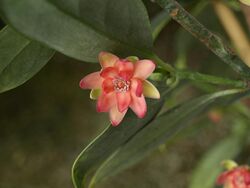Biology:Illicium henryi
| Illicium henryi | |
|---|---|

| |
| Scientific classification | |
| Kingdom: | Plantae |
| Clade: | Tracheophytes |
| Clade: | Angiosperms |
| Order: | Austrobaileyales |
| Family: | Schisandraceae |
| Genus: | Illicium |
| Species: | I. henryi
|
| Binomial name | |
| Illicium henryi Diels
| |
Illicium henryi, also known by the common names Henry anise tree and Chinese anise tree[1] is a species in the genus Illicium in the family Schisandraceae.
Description
Illicium henryi is a broad-leaved evergreen shrub or small tree, reaching 1.8-7m in height at maturity. Its leaves are entire, and are a glossy dark green above and slightly paler beneath. When crushed, the leaves are highly scented.[1]
Range
Illicium henryi is native to China ,[1] specifically the north-central, south-central, and southeast[2] or west.[3]
Etymology
Illicium is derived from Latin and means 'seductive'. The name is in reference to the plant's fragrance.[4]
Henryi is named for Augustine Henry (1857-1930), an Irish botanist who went on plant hunting expeditions to China, and who co-authored Trees of Great Britain and Ireland together with Henry John Elwes.[4]
References
- ↑ 1.0 1.1 1.2 "Illicium henryi". https://landscapeplants.oregonstate.edu/plants/illicium-henryi.
- ↑ Template:Cite powo
- ↑ "Illicium henryi". https://www.rhs.org.uk/Plants/9141/Illicium-henryi/Details.
- ↑ 4.0 4.1 Gledhill, David (2008). The Names of Plants. Cambridge University Press. pp. 196, 210. ISBN 9780521866453.
Wikidata ☰ Q1096405 entry
 |

